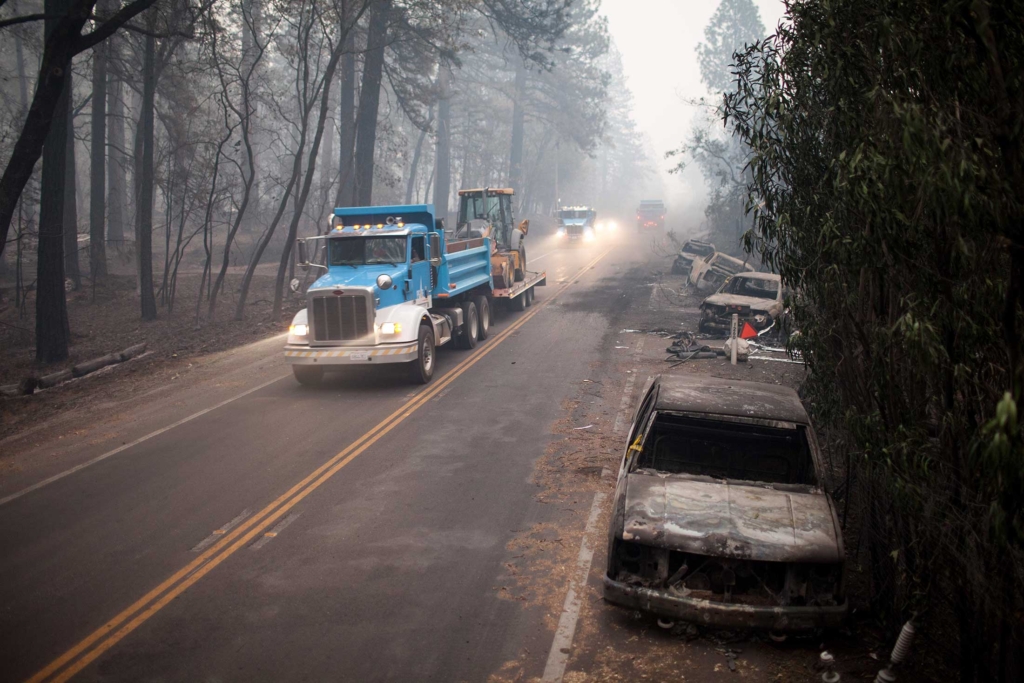California is stuck fighting climate change with a bankrupt, distrusted company

By Drake Bennett and Mark Chediak
28 February 2019
(Bloomberg Businessweek) – Laine Mason arrived at work on Nov. 8 expecting a busy day: Strong winds were forecast, which meant falling branches and toppled trees, and with them the possibility of downed power lines. Mason, who lives in the Northern California town of Corning, works for Pacific Gas & Electric Co. as what’s known as a “troubleman.” A 50-year-old former logger, he drives a robin’s-egg-blue PG&E bucket truck and wields a chainsaw and a 6-foot-long fiberglass hot cutter that can sever live power lines. In his words, “If you call PG&E and say, ‘Hey, my lights are out,’ they send me out to figure out what’s going on.”
That morning, Mason and two fellow troublemen were waiting for assignments in the company’s yard in Chico. At around 6:45, the others were sent out to deal with an outage on nearby Flea Mountain. A little later, Mason’s boss called and told him to head to Paradise, a town in the Sierra Nevada foothills, where another of his co-workers needed help. Mason could already see smoke, and on the road he passed a steady stream of cars headed the other way. In the time it took to drive 15 miles, a small blaze that had been spotted a few miles from Paradise had exploded into a wind-whipped, galloping monster. He was just outside town when the inferno arrived. “I saw the treetops start swirling around,” Mason says, “and within five minutes it was like midnight—the fire was there, the smoke was there.”
Mason worked all that day in Paradise, clearing fallen poles and lines. For a while he partnered with a team from the California Department of Forestry and Fire Protection, or Cal Fire, opening paths through the downed debris so the firefighters could go house to house urging holdouts to evacuate. He stayed on the south side of town, where the blaze was less intense, moving downhill when it edged closer, watching houses around him combust and smolder. His co-worker, he later discovered, had been trapped in the gridlock created by panicked evacuees on the north side and had survived by moving to the center of a large parking lot. Mason worked until 10 that night, went to Chico to grab a bite, then drove back up. When he finally left, he’d been on the clock for more than 36 hours. […]
The Camp Fire, as it was named, proved the deadliest and most damaging blaze in California history—85 people were killed, most of them in Paradise, and 18,800 buildings were destroyed. Cal Fire won’t conclude its investigation into the cause for months, possibly years, but the realization that PG&E’s equipment might be the culprit led in short order to a collapse in the utility’s stock price, the resignation of its chief executive officer, and, on Jan. 29, a declaration of Chapter 11 bankruptcy. On Feb. 28 the company reported to the Securities and Exchange Commission that it is “probable” PG&E equipment will be found to have started the Camp Fire. Survivors of the disaster, along with insurers and the town of Paradise, have already brought more than 40 lawsuits against PG&E, adding to 700 suits already on the books for its role in deadly fires that ravaged the state’s wine country in 2017. The plaintiffs’ attorneys—and angry protesters at the utility’s regulatory hearings and its San Francisco headquarters—portray a company whose negligence led to death and disaster. PG&E’s defense is that, for reasons beyond its control, it’s become impossible to prevent these catastrophic fires, no matter how careful the company is. [more]
California Is Stuck Fighting Climate Change With a Bankrupt, Distrusted Company